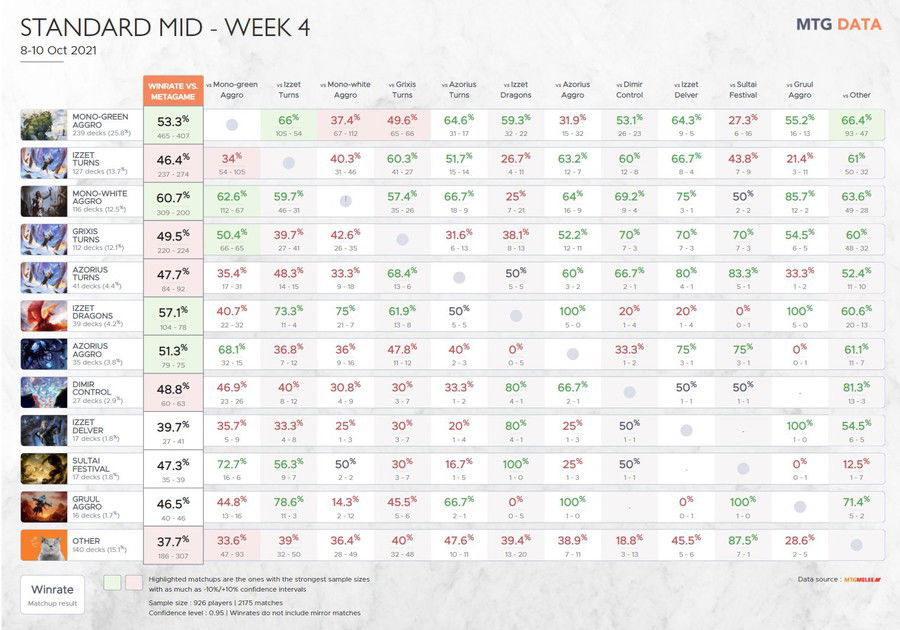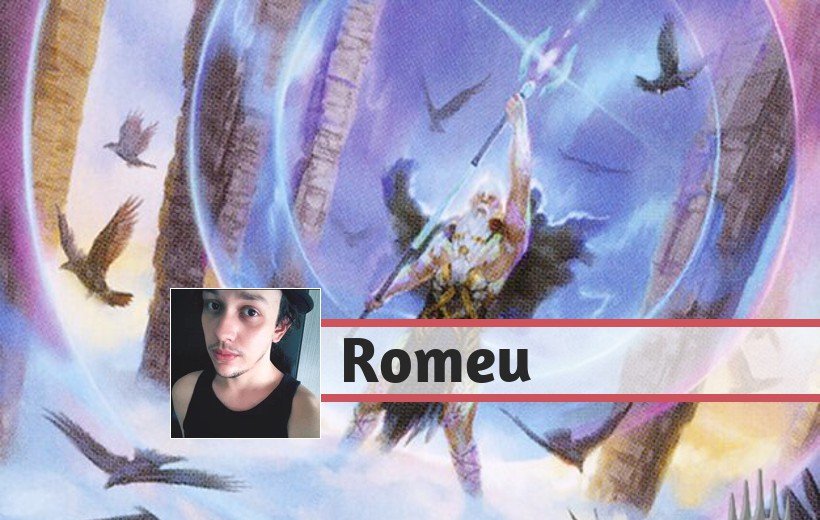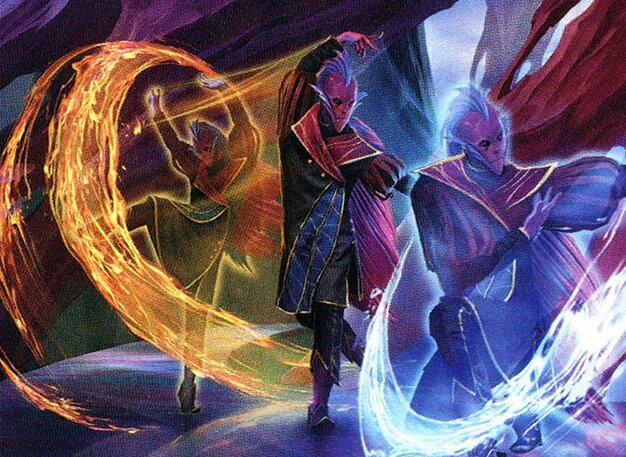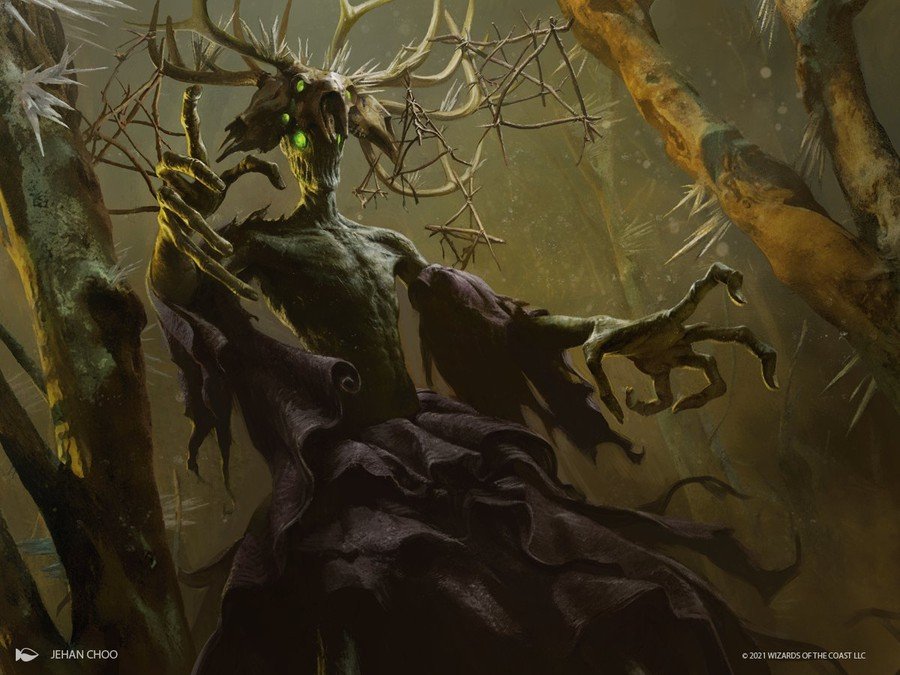The most controversial card on Standard oast week was definitely Alrund's Epiphany.

And when I refer to controversial, I essentially mean “card with an excess of debate about its future ban”, with extensive articles made defending the ban and non-ban of Standard's most famous extra turn today.
But after all, does Epiphany really deserve to be banned? Several big names in MTG, like Ross Merriam and Seth Manfield believe so, while other equally big players like Todd Anderson and Ari Lax believe it shouldn't.
Ad
I'll save you time and say that, as I'm writing this article, my answer is: I'm not sure because there are many points where it's understandable to think about a possible ban, and there are also many points where it doesn't seem required.
What I intend to elaborate in this article is an analysis of Standard's current situation, the space that Alrund's Epiphany decks have, the Metagame's behavior towards the card and the consequences of its banning or permanence in the format and, perhaps, at the end of it, I will be able to reach my personal conclusion after sharing this information and analysis with you.
Epiphany on Standard
Let's start by understanding the situation on top of a few points to get a general idea of what the state of Standard is currently and where Epiphany decks fit.
Alrund's Epiphany has a strange background, where it came as a card that was clearly going to become a format staple after the rotation, a fact that was evident during the Standard 2022 season, but which somehow seems to become unacceptable for the format with the inclusion of Galvanic Iteration in Innistrad: Midnight Hunt

If you're not familiar with Izzet Epiphany or haven't followed the World Championship or Standard games in general, the “combo” works like this: it casts Galvanic Iteration to copy Alrund's Epiphany, creating four tokens and accumulating two extra turns.
On the first extra turn, you use other cards to dig deep into the deck (commonly with Memory Deluge) to (probably) find another Alrund's Epiphany, and on the second extra turn, you'll use Galvanic Iteration's Flashback to repeat the sequence, which essentially means playing "alone" in a significant portion of turns and, if you don't win, you will be so far ahead in the game that your opponent will hardly be able to recover.
And what does the deck do while it can't close the streak of extra turns? Well, it controls the game with removals, sweepers, and sometimes it manages to win the game with Hall of the Storm Giants, it's the classic Combo-Control (I intend to delve deeper into this macro-archetype next week).
However, it is not only on Izzet Epiphany that the card has a significant impact.
Alrund’s Epiphany is essentially a format pillar alongside Esika’s Chariot, Wrenn and Seven, Goldspan Dragon, and Expressive Iteration.
And honestly, I consider Izzet Epiphany to be essentially the worst variant of decks with the extra turn because it's so focused on making the combo that it doesn't capitalize on turns as much as other variants do.
Take the Izzet Dragons, for example: not only does Goldspan Dragon make it easier to cast Epiphany on the next turn, but just one extra turn produced by the card generates so much value for you that you often won't need to play another one, especially if it is accompanied by a transformed Smoldering Egg.
And Grixis Epiphany, which is essentially a Lier Control that has the Alrund's Epiphany combo as part of its winconditions, and it's the main reason to consider it the best version: this variant plays the fair game a lot better than the Izzet lists because its answers are broader and better against some top Standard cards these days, which makes it much better against the format's overall Metagame.
Ad
The inclusion of Lier, Disciple of the Drowned makes each extra turn even more important because it's another turn where you open up a range of possibilities to accrue value against your opponent, while countered or discarded copies of Epiphany can be recast from the graveyard.

And let's not forget Galvanic Iteration, which can be devastating when used with other cards as well, as we saw in the Worlds, where it was used to copy from Demonbolt to remove threats against aggressive decks, to Go Blank to destroy the opponent's hand in a Mirror Match.
So, I see Grixis Epiphany as a natural evolution of Izzet, which can capitalize on the combo pieces, while having more comprehensive answers against the rest of the format.
In summary, Alrund's Epiphany is essentially a card that can win games on its own in the right combinations, and often without giving the opponent the opportunity to respond because its base is very solid and can wait as long as it takes to perform your combo.
How did an Extra Turn become an issue?
I've wondered this quite often as I watched the discussion grow on Twitter over the past week. After all, we've had a relatively similar combination of cards in past Standards, and it's never been a problem.
Seriously, Time Warp and Twincast were on the same Core Set and did absolutely nothing, even though they were in a format alongside Stoneforge Mystic, Celestial Collonade and Jace, the Mind Sculptor.

Obviously, Time Warp didn't put two tokens and Twincast couldn't be cast from the graveyard, and that brings us to the point we should look at how Alrund's Epiphany could have become a problem: the increase in power creep over the last decade, which, at this time, I believe we can exemplify with Mulldrifter and Baneslayer Angel.
Mulldrifters, Baneslayers & Titans
The Mulldrifters and Baneslayers theory was created by Patrick Chapin, and in summary it says that you have two categories of creatures that you should consider for your deck: Mulldrifters and Baneslayer Angels.

Mulldrifters are creatures that generate value from the moment you play them, whether drawing cards, creating tokens, dealing damage, destroying creatures, etc.
Examples of this category include most creatures with some ETB effect, but also creatures that generate immediate value during attack with Haste, or that punish the opponent for interacting with them, as cards like Prosperous Innkeeper, Shriekmaw , Shardless Agent or Spellstutter Sprite.
Baneslayers, in contrast, are creatures that don't generate any value, but are very efficient at turning the game around or quickly end the game if they stay on the board for a few turns.
Examples might include Tarmogoyf, Questing Beast, Death's Shadow, or Gurmag Angler.
Commonly, these cards will have different representations in a matchup, where Mulldrifter would normally serve to increase your resources or prolong the game, while a Baneslayer Angel has the goal of staying in play long enough to win on its own.
Ad
But it's been a few years and cycles where we've had cards that are Baneslayer Angel and Mulldrifter at the same time, which we call Titans after the Magic 2011/2012's famous Titan Cycle:

Titans are cards that offer immediate value in the game while are also threats that can end the game in a few turns, and the Titans were a powerful cycle throughout all their time in Standard, and I truly believe they would still be relevant if they were reprinted today.
I can list a significant number of Titans printed in Magic over the past few years, but let's stick to the main ones right now:

And when you have powerful Titans in a format, Time Warps become much better because the number of actions you have throughout the game add much more value.
An extra turn with a Baneslayer Angel adds five damage to your opponent and five life to you. An extra turn with a Mulldrifter is two more cards and a 2/2 body on the board.
But an extra turn with a Goldspan Dragon means four damage to the opponent and two mana for you to use however you like with a single card. The same can be said of Esika’s Chariot, or Wrenn and Seven, or any value-added threat used in conjunction with Alrund’s Epiphany.

Consider Smoldering Egg, which isn't exactly a Titan, but a card that essentially functions as a 0/4 Wall in Early-Game and that, after transforming, adds a Shock to all of your spells and, interestingly, can be transformed on its own with just one Epiphany.
Now consider this effect for the many creatures and Planeswalkers in Standard today and in future sets. How many of them can trigger a snowball effect in the game if you untap with them for a few turns, and how many, on their own, don't make the game simply impossible for the opponent after a few attacks or activations?
A Time Warp with a Baneslayer Angel is of little relevance, but a Time Warp with a Goldspan Dragon is devastating because it accumulates resources generated by it.
But there's also another perspective I'd like to mention here: Alrund's Epiphany is not a Time Warp, it's a Mulldrifter.

What I mean is that, in the current context, Alrund's Epiphany is not an extra turn, it is a “creature” (since it creates 2 tokens) that has an ETB effect of giving an extra turn for six or seven mana.
Mulldifter saw play in Control decks from your Standard days, and would you play a six-mana Mulldrifter that gives you an extra turn instead of drawing two cards? And would you be more inclined to play it if you could copy it for two or three mana with a spell that's also useful and synergistic with the rest of the deck?
In the current scenario, where more cards with snowball effects exist, having an “Extra Turn Mulldrifter” definitely makes a huge difference, and there is little reason not to use it.
Ad
Should Alrund's Epiphany be Banned?
There are several arguments as to why Epiphany should be banned, as well as arguments that defend its permanence in the format.
Starting with the most recent: the card was present in over 60% of the 2021 World Championship Metagame, with four Izzet Epiphany, four Grixis Epiphany, one Izzet Dragons and one Azorius Tempo.
Also, three of the four Top 4 decks at the event were lists with Epiphany, which symbolizes that it was more present than desired, right?
It depends on the perspective. Despite all the weight that the World Championship has, it is still a sixteen player event with a very select and sparse Metagame, and it is difficult to evaluate an entire format based on what we see in this tournament because the sample size is too small. You can't automatically name Izzet Dragons “the best deck of the format” because it managed to go 11-0 in the World Championship.
Ideally, we have to look at broader samplings, and in this regard, the MTGData website does an impressive job of presenting a large sample size from each week, and I'll be using their spreadsheet to do this analysis today.

If we look at the results of this weekend's events, provided by MTGData, we can see that no Epiphany deck achieved a winrate above 50%, with their main predators being Mono-White Aggro and Izzet Dragons (another Epiphany deck, technically), in a week which players were focused on dealing with them.
One important thing we need to remember about Standard is that the format is extremely cyclic when there is no absolute best deck on it, commonly having a "best deck of the week" rather than a "best deck of the format" and the target on the back of the “best deck of the week” grows and decreases as the Metagame adapts to it and players choose archetypes that prey on them, taking it away from the competitive landscape for a week or two, until it returns with other configurations or because it has a good match against next week's best deck.
And in that scenario, Epiphany decks have been “held” by the rest of the format this week, and we'll likely see the archetype need to adapt to these Metagame changes, and so the flow continues until the next release.
Another commonly used argument on this issue is that the format evolved around having only three viable decks: Epiphany, Mono-Green Aggro and Mono-White Aggro.
And looking at the numbers from the past fourteen days, it's true: Epiphany makes up about 35% of the Metagame, Mono-Green 28%, and Mono-White 10%, while the rest of the decks takes the other 27%, and this can and should be seen as a three-deck format, something that particularly doesn't seem to be a solution in this case, except to consider whether banning Alrund's Epiphany will really improve things, or if we'll just see the format polarize around another card: Esika's Chariot.
Ad

Which brings us to the third point mentioned over and over again: Izzet Epiphany pushes Midranges away, commonly forcing them into the spectrum of Aggro decks, as the excess of conventional answers doesn't usually outweigh the card selection quality that a Combo-Control has, regardless of how many Duress, Go Blank, or any other card you have to deal with them.
Which brings us back to Esika's Chariot, an absurdly powerful artifact used in Mono-Green Aggro and in the most diverse Gruul and Selesnya variants in the format, and which has a combination capable of winning games on its own with Wrenn and Seven, or just accumulate constant value with their tokens each turn, forcing the opponent to have an immediate answer or be swallowed by the amount of pressure offered by the artifact.
In a Midrange world, Esika's Chariot is much easier to answer than Alrund's Epiphany, as it's a permanent and cards like Binding the Old Gods or even a Putrefy or even Abrade reprint could give decks the means they need to resolve it (although the tokens remain in play).
The case of Alrund's Epiphany is quite different: there is no Duress or Go Blank that solves the problem because Foretell's cost essentially protects it from these effects, while offering inevitability. Which means that, to play against Epiphany, you need to be using counterspells, essentially forcing you to play blue.
And then I question another point: How long will Aggro be able to hold Epiphany decks?
As long as the cycle occurs, Midrange can return and prey on Aggro while being an easy prey to Epiphany decks, which are an easy prey for Aggro, and we have the natural Standard cycle forming.
Sounds like the ideal scenario, doesn't it?
Except if Midrange can't play the least bit well against a Combo-Control, another problem arises: Epiphany manages to adapt much better than the rest of the format.
Compare it to Mono-Green Aggro, which lacks the means, versatility and slots to adapt to the answers of a tweaked format, making it relatively obsolete, an element we commonly see in Mono-Red in past seasons.
For example, if you expect a Metagame with more creatures, what are your options? Increase the number of Inscription of Abundance or Devouring Tendrils?
And when there are more removals? You have Snakeskin Veil as a form of protection and... That's it.
Now consider Izzet Epiphany, which can have more counterspells, sweepers, threats, switch to Izzet Dragons, adjust to new variants like Grixis or Jeskai, use the right answers for the best deck of that week, and have much more accessibility and ease of making this for two reasons:
1) The package that defines its winconditions is composed of few cards, while each card from a more linear list like Mono-Green essentially works to win the game.
2) Its card selection package makes the archetype much more consistent in finding the necessary answers.
And what is the only deck that could adapt as much as Epiphany with the right answers to every Metagame change? Midrange decks.
Ad
And what are the best Midrange decks we would have in the format today?
I've searched for several lists within this macro-archetype in Standard that have done some result, and particularly, except for Izzet Dragons, most of them look like a bunch of good cards that work poorly together, or a bunch of bad cards that try to make a good thing together.
Mixing a Sacrifice subtheme with individually good cards is not a good strategy because the topdeck won't do you any good (and Midrange commonly take advantage that their topdeck is better than their opponent's after 1-for-1 exchanges).
The Rakdos versions are a good start, but essentially, they are Creatures + Removals lists that only look good at the moment because two of the three most played archetypes are Aggro, and I can't imagine them having advantages against Control decks, even without Alrund's Epiphany.
In other words, it's not just that the Midranges are pushed aside by Epiphany, it's also that the combinations for this strategy today include cards that don't seem to fit together to form a comprehensive strategy. The current non-Izzet midrange decks are clunky.
And the fact that the best Midrange in the format is currently an Izzet deck doesn't have much to do with Alrund's Epiphany, but rather that the Izzet shell in the current Standard is very powerful and consistent, and creates just the right mix that a Midrange should have between efficient answers, card advantage and threats that need to be answered immediately.
Because of that, even if the ban falls on Epiphany, I don't believe this situation will change, and the best Midrange will still be Izzet Dragons until we have better cards for other color combinations.
The Fun Factor
A point that I consider elementary for this matter, and I've seen few players commenting on it, is the fun factor.
This point is significant when we talk about Standard bans because it is Magic Arena's poster format, where Wizards aim to always grow the platform's engagement and the number of active players and, although we see some occasional examples of unfun decks like Tibalt's Trickery or Scute Swarm, they were never competitively viable, and the matchmaking would eventually take them to the very abysmal levels of the ranked games.
But Epiphany decks are very competitively viable and players will face it in the most diverse variants in ranked games and tournaments, which makes the fun factor a point to be analyzed when we talk about bans because there were cards that have already been banned for creating unfun game patterns:

In particular, Nexus of Fate, which essentially worked much like Alrund's Epiphany, as you would play an extra turn and use that turn to fetch another copy, to play another extra turn, and so on until winning the game.
Epiphany follows the same pattern, copying extra turns to create a game situation where victory is irreversible. And players hate to lose the game “for free” in the middle of a match.
Ad
Therefore, I consider that, even if the numbers show that the format is adapting, Alrund's Epiphany could always be on the verge of a banning for creating the kind of game that doesn't match what Wizards aims for Standard, where a player technically plays “alone” over and over again until he wins the game.
What I believe that should be done
With the archetype having a bad weekend in the overall Metagame, and with the possibility that the increased visibility at the Worlds makes it an even bigger target for players, I think the best option at the moment might be to just wait and see how the format develops, especially considering that Innistrad: Crimson Vow will be released in just over a month, and it's possible that the format will change again with the new set's additions.
On the other hand, as I mentioned earlier, Epiphany decks have a huge adaptability, and the possibility of them getting better as the Metagame develops is a real possibility, maybe even inevitable, and if Wizards anticipates the format cannot be healthy with Alrund's Epiphany because of this risk and the internal knowledge of what's planned for Crimson Vow, maybe banning it this week or next is an option.
But if it's to announce Standard bans, I would totally prefer Wizards to do the right job and announce the cycle of necessary bans all at once, rather than solving just one problem and then thinking about solving another when it becomes evident there are other problematic cards.
And when I mention problem cards, I'm saying that if Alrund's Epiphany gets banned, Esika's Chariot needs to leave as well because no matter how much people say there are answers to the artifact, it offers an absurd advantage and interacts too well with Wrenn and Seven and several other cards for us to consider it healthy to stay.

1 — Wait the next few weeks to see how the format will develop. If there aren't any outrageous discrepancies in the coming weeks, we can wait until Crimson Vow's release, which comes out in just over a month, and watch again.
2 — If the situation escalates, Alrund's Epiphany should be banned and, for the format's later health, Esika's Chariot also needs to leave to make the format more diverse and fun.
Conclusion
That was my analysis of the issue regarding Alrund's Epiphany, one of the most debated cards in recent weeks,
I am aware that a portion of players and readers may not agree with my point of view about the format, the card and the solutions that I consider healthy to apply, and this is natural: controversial issues, especially bans, always lead to great discussions with divergent opinions of all kinds.
What I like to remember in these moments of conflicting opinions is how small we are as individuals, and how minimal our decision-making power is in these matters and that the final decision is not mine or yours, so we don't need to act as if we are holders of the absolute truth.
Ad
Thanks for reading!








— 评论0
成为第一个发表评论的人